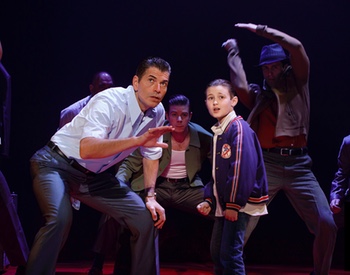Come From Away @ Playhouse Square, July 10, 2019
Laura Kennelly (for Cool Cleveland)

Set in Newfoundland, Come from Away, now at Playhouse Square, explores what happened in one corner of the world after the September 11, 2001 attacks on the World Trade Center and the Pentagon. Most of us can remember where we were and what we were doing when we heard the news on the day we now call “9/11.”
This engrossing, clever and mesmerizing production is every bit as good as the one I saw in New York two years ago. Written by Irene Sankoff and David Hein, it tells the 9/11 story from the viewpoint of those in Gander, Newfoundland, when air traffic was shut down for several days. No flying in or out of the United States stranded thousands.
Among those affected were nearly 7,000 people via 38 planes diverted to Gander (population 10,000). Come From Away, directed by Christopher Ashley, with music supervision by Ian Eisendrath, creates a narrative based on true stories collected by Sankoff and Hein.
Packed with Gaelic tunes, rhythmic narrative, bar tunes and more, all delightful, it highlights hospitality offered by townspeople used to living “on the edge of the world on an island in the sea.” Love and unlove, strangers meeting and parting, all play a role as we are swept into this “side effect” that no one could have imagined or planned. It’s not sappy “feel-good junk songs either — but it did leave most of us feeling hopeful (even joyous) as we left the theater. (If I had more space I’d tell you about the lost cell phone returned by strangers after the show and all the good will it showed.)
As the opening song, “Welcome to the Rock,” reveals, one reason the Newfoundlanders managed the sudden population increase so well is that in addition to being used to hardships, they also shared a great sense of humor. This came in handy when they buckled down to offer emergency housing and meals for thousands of (by now) crabby and scared passengers.
Why was so much help needed? Well, for one thing, all passenger baggage was locked inside the grounded planes, so ordinary necessities — think baby food, diapers, tampons, medicine (please never check necessary medicines) — had to be found. The people of Gander rallied and found space and provisions for the people (and even for the animals confined to the hold).
Brilliant musical staging (by Kelly Devine) and a functionally beautiful set (by Beowulf Boritt) add mightily to the show’s impact and wit as the cast swiftly moves chairs, tables, etc. when the story shifts from inside the planes to local bars, school gyms, and so on. Thanks to this, it’s easy to see what’s happening no matter where you sit (seats in the top balcony, where I was in NYC) and in the front rows (where I was in the Connor Palace) are equally good.
The excellent onstage band, led by conductor Cynthia Kortman Westphal (who played keyboard, accordion, and harmonium), included whistles, Irish flute, Uilleann pipes (Isaac Alderson), a fiddle (Kiana June Weber), guitars (Adam Stoler, Matt Wong, Max Calkin), and percussion (Steve Holloway and Ben Morrow).
Twelve fine actors play airline crew, passengers and townspeople. They switch roles and accents with such flawless precision I had to check my program later to be sure there were only twelve. They included Kevin Carolan, Harter Clingman, Nick Duckart, Chamblee Ferguson, Becky Gulsvig, Julie Johnson, Christine Toy Johnson, James Earl Jones II, Megan McGinnis, Andrew Samonsky, Danielle K. Thomas, Emily Walton, Marika Aubrey, Jane Bunting, Michael Brian Dunn, Julie Garnyé, Adam Halpin and Aaron Michael Ray.
BOTTOM LINE: Come From Away may even be perfect for skeptics who say they hate musicals because they judge them fake or too sentimental or too satirical or whatever. It’s none of those things. An unlikely subject for a musical? Probably, and yet, it’s a perfect mix of story and song that doesn’t wallow in tragedy or negative emotion. If you only go to one show this year, let it be this one.



